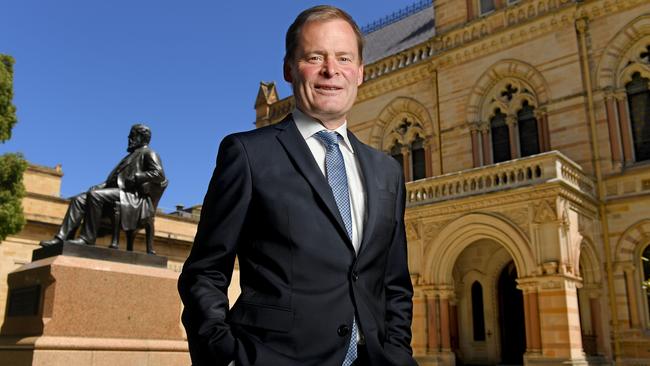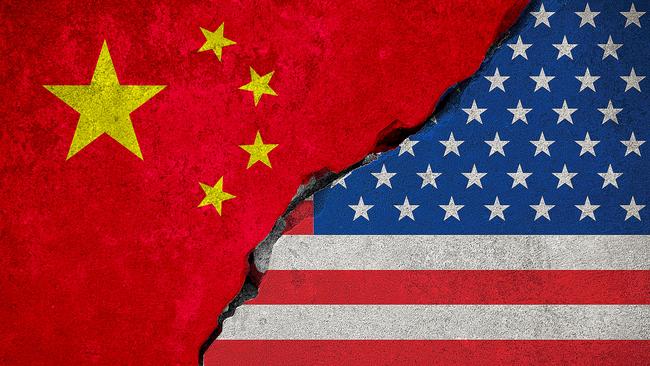Adelaide University is far financially too reliant on Chinese students, Centre For Independent Studies report warns
Our universities’ addiction to Chinese student fee revenue is a huge financial risk for the rest of us, writes Education Reporter Tim Williams.
Adelaide University is one of the most overexposed institutions to the Chinese student market in the English-speaking world, putting it at great financial risk from any downturn, a report warns.
A Centre for Independent Studies report lists Adelaide among seven “elite” Australian universities with “extraordinary levels of exposure” to the Chinese “cash cow”.
It says Chinese nationals account for 53.8 per cent of Adelaide’s international students and 15.8 per cent of all its enrolments.
Income from Chinese students was 13 per cent of Adelaide’s total revenue in 2017 – $120 million out of $929 million. All international students were worth $204 million to the uni that year.
From 2001-17, Adelaide grew its overseas student numbers by 322 per cent, compared to 49 per cent for domestic students.
Its foreign student numbers are up 27 per cent this year alone, to more than 10,000.
The report says the biggest financial risk factors are a Chinese recession, China introducing tighter currency controls on what its citizens can spend on foreign education, or adverse movements in exchange rates.
It says small percentage declines in Chinese enrolments could cause “significant financial hardship” to universities, while large declines would be “catastrophic”.
The bad news for taxpayers is that, like banks, universities are “too big to fail” and would need government bailouts, according to the report.
Adelaide vice-chancellor Peter Rathjen has previously blamed government funding woes for universities being “addicted” to foreign student revenue.

But the report rejects that argument, noting the biggest proportional rises in foreign student were in periods of funding increases.
Adelaide and UniSA bosses this week spoke of the need to “diversify” foreign student intake to reduce risk, but the report says that is “doomed to fail” because India is too poor and other markets too small.
The report says unis “routinely compromise” entry standards for foreign students via foundation courses, but Adelaide said its standards were the same regardless of the pathway. The uni said foreign students’ contribution to SA was more than economic.
UNIS’ CHINA SYNDROME
Analysis – Tim Williams
If Australia’s universities were to channel Prime Minister Scott Morrison, they’d collectively say “How good is China!”
The world’s most populous nation is also a global educational cash cow that Australian universities have milked for all its worth.
But there has long been debate about the growth of international student numbers, focused largely on China as it provides close to 40 per cent of them at university level.
The arguments in favour are the financial boon for unis, broader economic spinoffs worth billions, the cultural and educational benefits to our domestic students, and our enlivened city centres.
On the other side are concerns about exploitation of foreigners admitted to courses when they don’t have the English proficiency to cope with their study, or even to socialise with locals.
And lecturers pressured to lower academic standards and pass these students for the sake of the unis’ bottom lines.
In economically challenged SA, we’ve cheered our growing numbers (38,000 across all sectors including unis last year) evidenced by the cranes dotted around the CBD where student accommodation towers rise.

But we’ve lamented our inability to grow our overseas student body in Adelaide as fast as other cities.
Now a Centre For Independent Studies report warns Australian universities, and a group of seven “elite” ones in particular including Adelaide University, are hugely overexposed to the Chinese market.
It says Australia is an “extreme outlier” when compared to countries like the US, UK and Canada on China dependence, with a third to half of our unis having extremely high foreign student numbers by world standards.
At Sydney University and UNSW, Chinese student fees account for up to 23 per cent of total revenue. It’s 13 per cent for Adelaide University. Across the seven unis, a 50 per cent fall in Chinese enrolments would be a billion dollar revenue hit.
“They should act now to mitigate the risk of a sudden revenue collapse by raising admissions standards and reducing international student enrolments,” the report says.
Such a “collapse” is most likely to come from a recession in China, a big swing in exchange rates or the Chinese Government imposing stricter controls on what its citizens can spend on education overseas.
The report says while the latter seems unlikely, China has been booming for so long so it’s unclear how its leadership would react to a serious economic downturn. Its trade war with the US means we might be about to find out.

But getting unis to treat their own addiction to Chinese student fees before such a “catastrophic” scenario happens will be easier said than done. They all talk of their desire to “diversify” their foreign intake, but the report says: “The countries of South and South East Asia are either too small or too poor to contribute the desired numbers of fee-paying students.
“Even if a sufficient number of financially capable Indian students could be recruited to diversify ... recruiting them would likely require Australian universities to reach deep down into their talent pool, reducing (entry) standards still further.”
The universities also like to fall back on the argument that they’ve had no choice but to ramp up international student numbers because of government funding cuts.
The report shoots this down too, saying the greatest proportional growth in foreign students happened in the first decade of the 2000s when funding doubled. And even when funding for domestic student intake was uncapped from 2012-17 in a “demand-driven” system, unis still grew overseas student revenue five times as fast as government funding increases.
As long as the unis refuse to reduce the risk, taxpayers underwrite it with the prospect of a bailout, the report says.
“Just like the world’s leading banks in 2008 ... (they) are probably ‘too big to fail’.
“Like the CEOs of the big banks in 2008, the vice-chancellors of Australia’s big universities are, in effect, betting with other people’s money.”
Adelaide University said growing and diversifying its foreign student cohort was part of its strategic plan and stressed their contribution to the state was “more than an economic story”.
“We know that the presence of students from other countries enhances the educational and social experience of both our international and domestic students. The city of Adelaide itself has been culturally and socially enriched by international students living and studying here,” it said.
“The University of Adelaide has the same English-language entry standards as other universities in the prestigious Group of Eight. No matter what (entry) pathway they seek, all international students must meet the same English language entry standards.”
Federal Education Minister Dan Tehan said the annual value of Australia’s international education sector was now $37 billion.
He said unis were required to remain financially viable under the Higher Education Support Act and were monitored annually by the federal Education Department.
“In 2017, the total net operating surplus reported across the seven universities cited in the CIS report was $930.4 million,” Mr Tehan said.
“The Government has been working with the sector to strengthen English language requirements for international students by tightening regulations, improving data capture and increasing the scrutiny of visa applicants’ English language proficiency.”
The CIS report comes after the State Government announced its international education targets of raising the sector’s value to the SA economy from $1.8 billion to $3 billion by 2030. Student numbers would rise to 71,000.
